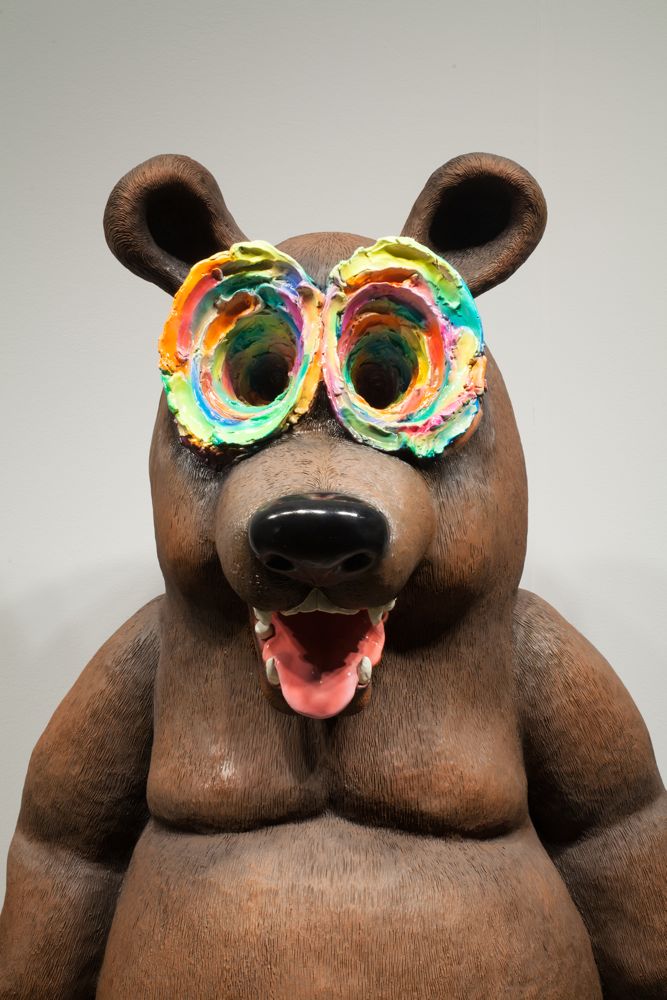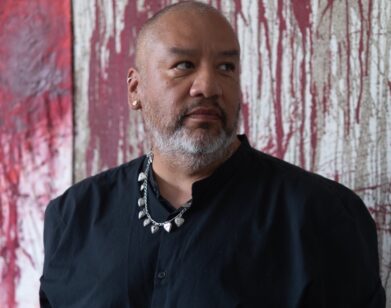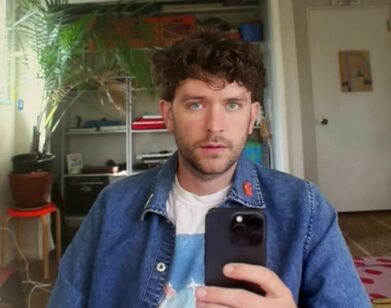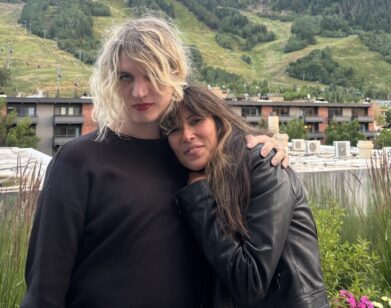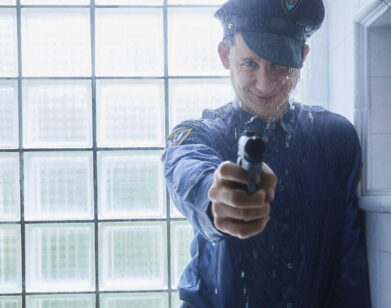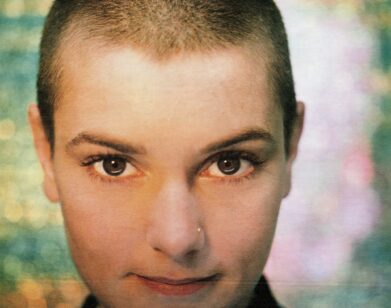Tony Tasset’s Three Story Eyeball
Artist Tony Tasset is literally staring out over Dallas. For his most recent public installation, the Chicago-based sculptor took a picture of his own eyeball, and blew it up to a veiny, three-story fiberglass orb, peering at downtown’s Joule Hotel. The result? A glaring work, and the sneaking feeling you are being watched. Full frontal eye contact. Gazed and confused.
Though you shouldn’t be–the thing is, Eye is really just an eye. “People have been so conditioned to not understand art that when something’s obvious they feel like they’re missing something,” Tasset says. “It’s a big eyeball.”
Tasset’s focus is in pinpointing objects that are widely recognizable, easily construed by anyone. As far as spurring reactions, Eye seems to be working: On one end, a homeless man wrote an enraged screed proclaiming the Eye was a false god; on the other, Flaming Lips singer Waynee Coyne shared the pithier sentiment “…fuck yeah!!!” in an Instagram of the still-under-construction sphere. “I was quite honored,” admits the artist.
Born in Cincinnati in 1960, Tasset studied painting at the Art Institute of Chicago. His work progressed towards sculpture as he explored concepts that could communicate to broader publics instead of merely an art elite. Take Rainbow (2012), a 94-foot high arch of color curving over the Sony Studios lot in Culver City, California. In addition to making a vivid landmark, the work nods to the fact that The Wizard of Oz was filmed on the property (formerly that of MGM Studios) decades earlier. Magnolias for Pittsburgh (2006) are two bronze magnolia trees situated in a magnolia grove in downtown Pittsburgh. A passerby might mistake it for the real thing in spring; but in winter, the bronze flowers alone remain in bloom.
Currently, Tasset is working on Artists Monument, a monolithic slab emblazoned with alphabetized names of around 400,000 artists—everyone who’s been exhibited in the 21st century. Each person that Tasset could find on the Internet, from the subjects of major museum retrospectives to every starving artist who’s had a single gallery show, is indexed. Set to be unveiled next year in New York, the piece is meant to spin an egalitarian view of the art world.
Before our photographer shot Tasset in his bathtub at the Ace Hotel, we spoke with him in the lobby.
RACHEL SMALL: Major public commissions like this definitely seem like a career high point. But, going back, when did you start making art, and how did your style develop?
TONY TASSET: I’ve been an artist forever. I started when I was in the third grade. I drew drawings of monsters and I sold them to my classmates for a dime. I studied painting. Originally I was a design and illustration major, but I met this girl. Back then, if you were a designer, you were a real sellout, and she was a real hardcore painter. I knew she would never take me seriously unless I was an art major, so I switched majors to fine arts. Anyway, we’re married now. So it worked. How I got to my style? I’m a weird artist in that everything I do looks a little different.
SMALL: I feel like that’s the norm for a lot of artists.
TASSET: It’s kind of the postmodern thing. I didn’t do that much sculpture during school. It just happened. So, as far as the big public pieces, every public commission is different. It’s different making art for a public, more difficult than for a gallery. I’m really trying to make art that speaks to the biggest audience possible. Take the Eye, for example. First of all I wanted to not decorate the space, but really activate the space. So, you put in a 30-foot eyeball and it turns the downtown into this surreal, funky set, and it makes you, the viewer, a participant in this weird stage set.
SMALL: Talk about interacting with art. You can’t really ignore this staring back at you.
TASSET: Right. An eyeball is just a classic. I try to make work that kind of keys into things that are already familiar. They know what an eye is like. There’s no mystery to it. Still people ask, “What’s it mean?”
SMALL: An eyeball is an eyeball. It is a very large eyeball. I was looking at pictures of it. The veins are really pronounced. From one angle, it looks like marble, but if you turn it around, then you immediately recognize the iris, and register the red marks as veins.
TASSET: It’s just a little bit creepy. It’s based on a photograph I took of my eye. So, maybe my eyes are really bloodshot.
SMALL: So you’ve done a number of large-scale sculptors in cities Culver City, Pittsburgh, Chicago. How do you decide on objects for each city?
TASSET: I really try to be open. I don’t want to go there with the idea that I’m giving them a Tony Tasset. For Rainbow, I was just trying to make something really, really big that you can see for miles around. In my own little way, I wanted to compete with the Hollywood sign. They’re really trying to not be ignored.
SMALL: You created a monumental pile of snow in Chicago called appropriately Snow Pile for Chicago, and you’ve also made a series of super-realistic dirty snowmen sculptures.
TASSET: I make work that tries to sort of connect with something really, really familiar. So, a snowman is a figurative sculpture that people make. I’m trying to blur the distinction between high art and low art. I think it puts the viewer on guard in a lot of ways. They’re not sure how to take this. With a snowman, I’m just trying to honor this almost folk tradition that people do. Anyway. So, in a way I make my snowman, but it has a connection with all the other snowmen that have ever been made. I’ve made a few snowmen, and the first one I made had a sad face on it. I made it right after we went into the Gulf War. To kind of try it out first, it had actually snowed in Chicago. So, I made this sad snowman [from real snow] with this sad charcoal mouth, and it was out in the front yard. That one was made out of real snow. That same day, people had snowmen all up and down the street. The next morning my snowman was knocked over, and the other snowman weren’t. I feel like making a sad face somehow was like sacrilegious or something. It somehow offended somebody on some weird level.
SMALL: What was the first faux object you made?
TASSET: It was just a Styrofoam cup, torn it into a spiral. I was thinking about making a mark of gesture, but again to be the most quotidian, most banal gesture that everybody makes. Anyway, I made this bronze cup, painted it white, and laid it on the floor of the gallery. People looked at it. They thought it was just garbage, and then when they realized it was bronze they loved it, thought it was great. It’s very classic. Art comes from artifice—the idea of remaking something is what artists do. It’s a classic thing.
SMALL: I feel like that forces you to rethink the object. It’s very witty, almost, especially because bronze is a more decadent material to shape into something that would be trash.
TASSET: It was either stolen or thrown out a couple times.
SMALL: It’s funny that one person would think to throw it out and another to would think to steal it. Going back to the Eye, the work was originally commissioned as a temporary installation in Chicago. Now that it’s in Dallas, have you noticed anything interesting about the way it sits in the city?
TASSET: It’s pointed at the Joule Hotel. [Owner Tim Headington] is the guy who bought it. From the hotel rooms, you look outside and there’s this big eyeball.
SMALL: I guess if you think about it, it really is sort of you looking out at this hotel. How else does location in cities play into how you design the sculpture?
TASSET: On one hand, I’ll go to Kansas, where I’ve been commissioned to do a piece in front of a federal building, and I’ll try to learn about the city or the area. In Los Angeles, when I realized The Wizard of Oz was filmed at the Sony studios, I felt like I had to acknowledge that. It’s funny because I try to make work that speaks to the public, but I don’t have town meetings with the public or anything. I trust my own instincts as to what will communicate. The Beat poets said that. Allen Ginsberg talked about “First thought, best thought.” Talk about Interview—Warhol’s attitude of “Whatever, I’m going to make something else tomorrow,” it’s refreshing. It freed me up a lot to not second-guess myself.
SMALL: Is Warhol an inspiration?
TASSET: Oh yeah. He certainly was the king of high and low. Look, I’m not going to say anything new about Warhol, but I do love his American egalitarianism. He both will make a painting of Marilyn Monroe, or movie stars, but then he’ll also take the drug addicts and lowlifes of society and he’ll make them into stars.
SMALL: You started teaching in 1989. What do you think it’s important for your students to learn as aspiring artists?
TASSET: Here’s my teaching philosophy. I try to teach a modernist and postmodernist position. On one hand, if you’re a painter, you need to know the history of painting. But I’m also interested in the moment we live in. I love television, and movies, and books, and music. So I also think of art as this cultural production along with all this other stuff that’s happening. So that’s a kind of postmodern, not media-specific, but the times, what is your art relevant to this moment we live in versus media specificity? That’s my teaching philosophy, both of those things are important.
SMALL: How do you think, the eye, for instance, plays into that moment?
TASSET: Well, it’s certainly very historical. Like I said the pharaoh’s eye, the masonic eye, the eye atop the totem pole. It’s a classic, but it’s also just pop and goofy. It’s pop. Like you said that Halloween, candy that’s like bloody eyeballs and stuff. So, it’s a very pop-culture thing at the same time, I think.
SMALL: When you said “of this time,” the first thing I think of was how there’s so much surveillance in cities now.
TASSET: When I was in Chicago, several people certainly made a connection with how in downtown Chicago, there are cameras everywhere. There’s Big Brother. That’s in there, for sure, too. I’m trying to get it reduced down to this simplest, simplest thing. I don’t try to make work that’s original. I try to make work that’s quintessential. Meaning, an eyeball seems to be the quintessential kind of surrealist sculpture. That’s what I mean about the familiar. It operates with stuff that people already know or information that they already have and I try to just use that. Quintessential means like the perfect minimalist sculptor. The perfect snowman. When I was growing up, I had two kind of beat-up picture books about Norman Rockwell and Walt Disney. They’re both great at that, at finding the quintessential. I’m making snowmen. They’re not much different than some of Rockwell’s paintings. The sentiment is more complicated, but I think they were really good at finding those iconic, quintessential, perfect kind of descriptions that people read and they get it and it sticks with them.
EYE IS PERMANENTLY ON VIEW IN DOWNTOWN DALLAS.

